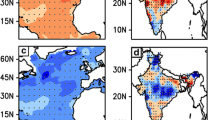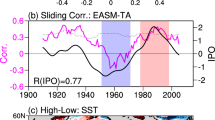Abstract
The present study shows that the weak (out-of-phase) correlation between the boreal spring Atlantic Meridional Mode (AMM) index and Indian summer monsoon rainfall (ISMR) during the 1990–2001 periods turned into a significant positive relationship after that. During the first period, boreal spring (MAM) season Atlantic SST variability is dominated by stronger cooling in the southeastern region. After 2002, the spring season SST pattern has north Atlantic warming extending to the equatorial region and continuing to summer (JJAS). The primary mode of the Atlantic SST co-occurred with a pre-existing El Nino during period 1 and the formation of La Nina by summer during period 2. During period 1, ENSO-induced anomalies dominated with weak divergence over India and the Atlantic region, while during period 2, the warm SST anomalies of north Atlantic-induced off-equatorial convection and associated circulation extended to the Indian Ocean and Indian land region resulting in increased monsoon rainfall during JJAS. The study further showed that during period 2, the increased correlation of ENSO and ISMR is also contributed by the Atlantic SST anomalies with additional off-equatorial wind anomalies and circulation from the north Atlantic extending to the Indian Ocean and monsoon region. Thus, MAM season Atlantic SST anomalies play a significant role in ENSO phase reversal and ISMR during the recent period. Many of the seasonal prediction models that participated in the NMME project capture the phase reversal of AMM-ISMR correlation when initialized during February. But models have more robust equatorial SST patterns during the summer season, and the north Atlantic SST anomalies are vital in the absence of ENSO. The study indicates that the spring season AMM index can provide a predictive signal for ISMR in seasonal prediction models. Still, they need to improve the simulation of the Atlantic basic state and its teleconnection with the tropical east Pacific.













Similar content being viewed by others
Data Availability
All the atmospheric data sets ( zonal and meridional wind ) are available from ERA5 (https://cds.climate.copernicus.eu/#!/search?text=ERA5&type=dataset), HadISST from https://www.metoffice.gov.uk/hadobs/hadisst/data/download.html and IMD rainfall from https://www.imdpune.gov.in/Clim_Pred_LRF_New/Grided_Data_Download.html. and the NMME model outputs are from the IRI website http://iridl.ldeo.columbia.edu/SOURCES/.Models/.NMME/.
Code Availability
The software used was GrADS freely available from http://cola.gmu.edu/grads/ and scripts are available.
References
Ashok K, Guan Z, Saji NH, Yamagata T (2004) Individual and combined influences of ENSO and the Indian Ocean Dipole on the indian summer Monsoon. J Clim 17:3141–3155
Ashok K, Guan Z, Yamagata T (2001) Impact of Indian Ocean Dipole on the relationship between the indian monsoon rainfall and ENSO. Geophys Res Lett 28:4499–4502
Ashok K, Saji NH (2007) On the impacts of ENSO and Indian Ocean dipole events on sub-regional indian summer monsoon rainfall. Nat Hazards 42:273–285. https://doi.org/10.1007/s11069-006-9091-0
Attada R, Ehsan MA, Pillai PA (2022) Evaluation of potential predictability of indian summer Monsoon Rainfall in ECMWF’s Fifth-Generation Seasonal Forecast System (SEAS5). Pure Appl Geophys 179:4639–4655. https://doi.org/10.1007/s00024-022-03184-9
Bamzai AS, Shukla J (1999) Relation between eurasian snow cover, snow depth, and the indian summer monsoon: an observational study J. Clim 12:3117–3132
Borah PJ, Venugopal V, Sukhatme J, Muddebihal P, Goswami BN (2020) Indian monsoon derailed by a North Atlantic wavetrain. Science. 370(6522):1335–1338. doi: https://doi.org/10.1126/science.aay6043. PMID: 33303616
Cai W, Wu L, Lengaigne M et al (2019) Pantropical climate interactions. Science. https://doi.org/10.1126/science.aav4236
Chakravorty S, Gnanaseelan C, Pillai PA (2016) Combined influence of remote and local SST forcing on indian summer Monsoon Rainfall variability. Clim Dyn 47:2817–2831. https://doi.org/10.1007/s00382-016-2999-5
Chang P, Fang Y, Saravanan R, Ji L, Seidel H (2006) The cause of the fragile relationship between the Pacific El Nin˜o and the Atlantic El Nin˜o. Nature 443:324–328
Chiang JCH, Vimont DJ (2004) Analogous meridional modes of atmosphere-ocean variability in the tropical Pacific and tropical Atlantic. J Clim 17(21):4143–4158
Devika M, Pillai PA (2020) Recent change in trend, prominent modes and the interannual variability of indian summer monsoon rainfall centered on early 21st century. Theoret Appl Climatol 139:815–824
Doi T, Tozuka T, Yamagata T (2009) Interannual variability of the Guinea Dome and its possible link with the Atlantic Meridional Mode. Clim Dyn 33:985–998
Goswami BN, Madhusoodanan MS, Neema CP, Sengupta D (2006) A physical mechanism for North Atlantic SST influence on the indian summer monsoon. Geophys Res Lett 33:L02706. https://doi.org/10.1029/2005GL024803
Ham YG, Kug JS, Park JY, Jin FF (2013) Sea surface temperature in the north tropical Atlantic as a trigger for El Niño/Southern Oscillation events. Nat Geosci. https://doi.org/10.1038/ngeo1686
Hersbach H, co-authors (2020) The ERA5 global reanalysis.Quart. J Royal Met Soci 146:1999–2049
Huffman GJ, Adler RF, Bolvin DT, Gu G (2009) Improving the global precipitation record: GPCP Version 2.1. Geophys Res Lett 36:L17808. https://doi.org/10.1029/2009GL040000
Hu ZZ, Huang B (2007) Physical processes associated with the tropical Atlantic SST gradient during the anomalous evolution in the southeastern ocean. J Clim 20:3366–3378
Kirtman BP, co-authors (2014) The north american multi-model ensemble. Bull Am Meteorol Soc 95:585–601
Kripalani RH, Kulkarni A (1996) Assessing the impacts of El Nino and non-El Nino related droughts over India. Drought Netw News 8(3):11–13
Kripalani RH, Kulkarni A (1999) Climatology and variability of historical soviet snow depth: some new perspectives in snow-indian monsoon teleconnections. Clim Dyn 15:475–448
Krishnamurthy V, Goswami BN (2000) Indian monsoon–ENSO relationship on interdecadal time scales. J Clim 13:579–595
Krishnan R, Sugi M (2003) Pacific decadal oscillation and variability of the indian summer monsoon rainfall. Clim Dyn 21:233–242. https://doi.org/10.1007/s00382-003-0330-8
Kucharski F, Bracco A, Yoo J, Molteni F (2007) Low-frequency variability of the indian monsoon–ENSO relationship and the tropical Atlantic: the weakening of the 1980s and 1990s. J Clim 20(16):4255–4266
Kucharski F, Bracco A, Yoo J, Tompkins A, Feudale L, Ruti P, Dell’Aquila A (2009) A Gill-Matsuno-type mechanism explains the tropical Atlantic influence on african and indian monsoon rainfall. Q J R Meteorol Soc 135(640):569–579
Kumar KK, Rajagopalan B, Cane MA (1999) On the weakening relationship between the indian monsoon and ENSO. Science 284:2156–2159
Li S, Perlwitz J, Quan X, Hoerling MP (2008) Modeling the influence of North Atlantic multidecadal warmth on the indian summer rainfall. Geophys Res Lett 35:L05804. https://doi.org/10.1029/2007GL032901
Pai DS, Sridhar L, Rajeevan M, Sreejith OP, Satibhai N, Mukhopadhyay B (2014) Development of a new high spatial resolution (0.25 × 0.25) long period (1901–2010) daily gridded rainfall data set over India and its comparison with existing data sets over the region. Mausam 65(1):1–18
Pillai PA, Annamalai H (2012) Moist Dynamics of severe Monsoons over South Asia: role of the Tropical SST. J Atmos Sci 69:97–115
Pillai PA, Mohankumar K (2010) Individual and combined influence of El Niño–Southern Oscillation and Indian Ocean Dipole on the Tropospheric Biennial Oscillation. Q J R Meteorol Soc 136:297–304. https://doi.org/10.1002/qj.579
Pillai PA, Ramu DA, Nair RC (2021) Recent changes in the major modes of asian summer monsoon rainfall: influence of ENSO-IOD relationship. Theoret Appl Climatol 143:869–881
Pillai PA, Rao SA, Gangadharan KV, Pradhan M, Srivastava A, Jain DK (2022) Impact of reduced ENSO variability and amplitude on ISMR prediction in the long-lead forecasts of monsoon mission CFS. Int J Climatol 42(16):9166–9181. https://doi.org/10.1002/joc.7809
Pillai PA, Rao SA, Ramu DA, Pradhan M, George G (2018) Seasonal prediction skill of indian summer monsoon rainfall in NMME models and monsoon mission CFSv2. Int J Climatol 38:847–861
Rajeevan M, Pai DS, Thapliyal V (2002) Predictive relationship between indian ocean sea surface temeprature and indian summer monsoon rainfall. Mausam 53:337–348
Rajeevan M, Sridhar L (2008) Inter-annual relationship between Atlantic sea surface temperature anomalies and indian summer monsoon. Geophys Res Lett 35:L21704
Rao SA, Pillai PA, Pradhan M, Srivastava A (2019) Seasonal prediction of indian summer monsoon in India: the past, the present, and the future. Mausam 70:265–276
Rasmusson EM, Carpenter TH (1983) The relationship between eastern equatorial Pacific sea surface temperature and rainfall over India and Sri Lanka. Mon Wea Rev 111:517–528
Rayner N, Parker DE, Horton E, Folland C, Alexander L, Rowell D, Kent EC, Kaplan A (2003) Global analyses of sea surface temperature, sea ice, and night marine air temperature since the late nineteenth century. J Phys Res 108(D14):4407. https://doi.org/10.1029/2002JD002670
Ren H, Zuo J, Li W (2021) The impact of Tropical Atlantic SST variability on the Tropical atmosphere during Boreal Summer. J Clim 3416:6705–6723
Rodwell MJ, Hoskins BJ (2001) Subtropical anticyclones and summer monsoons. J Clim 14:3192–3211. https://doi.org/10.1175/1520-0442(2001)0143192:SAASM2.0.CO;2
Sabeerali CT, Ajayamohan RS, Rao SA (2019) Loss of predictive skill of indian summer monsoon rainfall in NCEP CFSv2 due to misrepresentation of Atlantic Zonal Mode. Clim Dyn 52(7–8):4599–4619. https://doi.org/10.1007/s00382-018-4390-1
Saji NH, Goswami BN, Vinayachandran P, Yamagata T (1999) A dipole mode in the tropical Indian Ocean. Nature 401:360–363
Saji NH, Yamagata T (2003) Possible impacts of Indian Ocean dipole mode events on global climate. Clim Res 25:151–169. https://doi.org/10.3354/cr025151
Vittal H, Villarini G, Zhang W (2020) Early prediction of indian summer rainfall by Atlantic Meridional Mode. Clim Dyn 54:2337–2346
Walker GT (1924) Correlation in seasonal variRajeevanations of weather. IV: a further study of world weather. Mem. Indian Meteorol Dept 24:275–332
Webster PJ, Yang S (1992) Monsoon and ENSO: selectively interactive systems. Quart J Roy Meteor Soc 118:877–926
Yang X, Huang P (2021) Restored relationship between ENSO and indian summer monsoon rainfall around 1999/2000. Innovation 2:1–8
Acknowledgements
The authors are thankful to Dr. R. Krishnan, Director, Indian Institute of Tropical Meteorology (IITM), and Dr. Suryachandra A Rao, Program manager, Monsoon Mission, IITM for encouraging to carry out this research work. The IITM HPC support is duly acknowledged. A. R Dhakate and Kiran V. G also acknowledge Savitribhai Pule University Pune. The IITM is fully funded by the Ministry of Earth Sciences, Government of India. The authors have no conflicts of interest to declare. All the figures are prepared using GrADS software available freely (http://cola.gmu.edu/grads/).
Funding
No funding was received to conduct this study.
Author information
Authors and Affiliations
Contributions
P.A Pillai- Conceptualisation, supervision, methodology, plotting, validation, writing reviewing, and editing.
A.R Dhakate- Formal analysis, Validation, Software, plotting.
Kiran V.G- Data availability, plotting, reviewing.
Corresponding author
Ethics declarations
Conflict of Interest
The authors declare no competing interests.
Ethics Approval
It is not necessary.
Consent to participate
All authors approved.
Consent for publication
All authors approved.
Additional information
Publisher’s Note
Springer Nature remains neutral with regard to jurisdictional claims in published maps and institutional affiliations.
Rights and permissions
Springer Nature or its licensor (e.g. a society or other partner) holds exclusive rights to this article under a publishing agreement with the author(s) or other rightsholder(s); author self-archiving of the accepted manuscript version of this article is solely governed by the terms of such publishing agreement and applicable law.
About this article
Cite this article
Pillai, P.A., Dhakate, A.R. & G, K.V. Different role of spring season Atlantic SST anomalies in indian summer monsoon rainfall (ISMR) variability before and after early 2000. Clim Dyn 61, 2783–2796 (2023). https://doi.org/10.1007/s00382-023-06725-7
Received:
Accepted:
Published:
Issue Date:
DOI: https://doi.org/10.1007/s00382-023-06725-7




